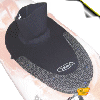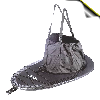
A kayak is a small, narrow watercraft which is typically propelled by means of a double-bladed paddle. The word kayak originates from the Greenlandic word qajaq.

Kayaking is the use of a kayak for moving over water. It is distinguished from canoeing by the sitting position of the paddler and the number of blades on the paddle. A kayak is a low-to-the-water, canoe-like boat in which the paddler sits facing forward, legs in front, using a double-bladed paddle to pull front-to-back on one side and then the other in rotation. Most kayaks have closed decks, although sit-on-top and inflatable kayaks are growing in popularity as well.

A canoe is a lightweight narrow water vessel, typically pointed at both ends and open on top, propelled by one or more seated or kneeling paddlers facing the direction of travel and using a single-bladed paddle.
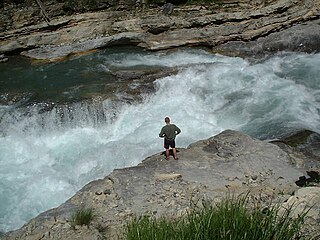
Whitewater forms in a rapid context, in particular, when a river's gradient changes enough to generate so much turbulence that air is trapped within the water. This forms an unstable current that froths, making the water appear opaque and white.
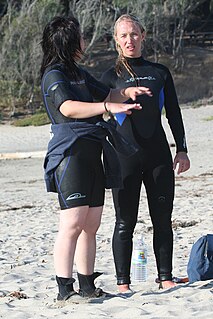
A wetsuit is a garment worn to provide thermal protection while wet. It is usually made of foamed neoprene, and is worn by surfers, divers, windsurfers, canoeists, and others engaged in water sports and other activities in or on water. Its purpose is to provide thermal insulation and protection from abrasion, ultraviolet exposure, and stings from marine organisms. It also contributes extra buoyancy. The insulation properties of neoprene foam depend mainly on bubbles of gas enclosed within the material, which reduce its ability to conduct heat. The bubbles also give the wetsuit a low density, providing buoyancy in water.

A dry suit or drysuit provides the wearer with environmental protection by way of thermal insulation and exclusion of water, and is worn by divers, boaters, water sports enthusiasts, and others who work or play in or near cold or contaminated water. A dry suit normally protects the whole body except the head, hands, and possibly the feet. In hazmat configurations, however, all of these are covered as well.
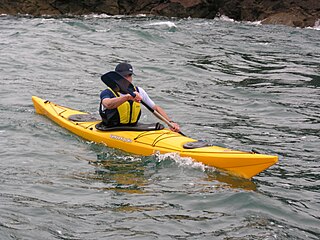
A sea kayak or touring kayak is a kayak developed for the sport of paddling on open waters of lakes, bays, and the ocean. Sea kayaks are seaworthy small boats with a covered deck and the ability to incorporate a spray deck. They trade off the manoeuvrability of whitewater kayaks for higher cruising speed, cargo capacity, ease of straight-line paddling, and comfort for long journeys.
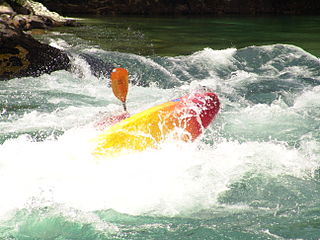
Whitewater kayaking is an adventure sport where a river is navigated in a decked kayak. Whitewater kayaking includes several styles. River running; where the paddler follows a river and paddles rapids as they travel. Creeking usually involving smaller, steeper, and more technical waterways. Creek boats tend to be short but high volume to allow for manoeuvrability while maintaining buoyancy. Slalom requires paddlers to navigate through "gates". Slalom is the only whitewater event to be in the Olympics. Play boating involves staying on one feature of the river and is more artistic than the others. Squirt boating uses low-volume boats to perform special moves in whitewater features.

Wildwater canoeing is a competitive discipline of canoeing in which kayaks or canoes are used to negotiate a stretch of river speedily. It is also called "Whitewater racing" or "Downriver racing" to distinguish it from whitewater slalom racing and whitewater rodeo or Freestyle competition.

Canoe slalom is a competitive sport with the aim to navigate a decked canoe or kayak through a course of hanging downstream or upstream gates on river rapids in the fastest time possible. It is one of the two kayak and canoeing disciplines at the Summer Olympics, and is referred to by the International Olympic Committee (IOC) as Canoe/Kayak Slalom. The other Olympic canoeing discipline is canoe sprint. Wildwater canoeing is a non-Olympic paddlesport.
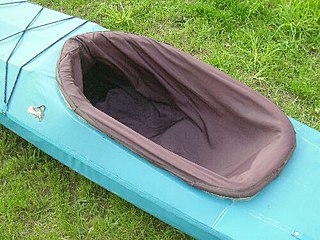
A sea sock is a piece of safety equipment used in sea kayaking. It is a large waterproof bag, fitting the lower body of a kayaker, that is placed inside the kayak and attached tightly all around the rim of the cockpit. The paddler sits inside the sea sock and fits the sprayskirt over the sea sock and cockpit coaming as usual.

Squirt boating is a form of whitewater rafting or canoeing where the boat is designed to be as low in volume as possible while still allowing the paddler to float. Squirt boats are designed to use both surface and underwater currents to maneuver within the water. These maneuvers can be used to effect navigational control or to perform tricks.
The Lyme Bay kayaking disaster was an 1993 incident that led to the death of four teenagers on a sea kayaking trip in the Lyme Bay area on the south coast of England. The incident led to legislation to regulate adventure activities centres working with young people in the United Kingdom.
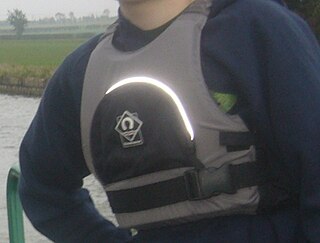
Buoyancy aids are a specialist form of personal flotation device (PFD) used most commonly by kayakers, canoeists and dinghy sailors. They are designed as a flotation aid, rather than a life-saving device and have several key differences to other PFD's and lifejackets. Regardless of the specification of buoyancy aids, they do not provide the same high level of protection as lifejackets.

A tuilik is an Inuit watertight jacket, used when paddling a kayak. It is sealed at the face, at the wrists and around the cockpit coaming. In this way the paddler can capsize and come back upright without getting wet, and without getting any water into the kayak.

A survival suit, more accurately and currently referred to as an immersion suit, is a type of waterproof dry suit intended to protect the wearer from hypothermia if immersed in cold water or otherwise exposed after abandoning a vessel, especially in the open ocean. Immersion suits usually have integral footwear, and a hood, and either built-in gloves or watertight wrist seals. Suits manufactured by several manufacturers also include an inflatable pillow which is permanently attached high on the back, or an inflatable tube that is attached with zippers at two points on the chest, each side of the main zipper, and circles the back. When inflated, both of these devices provide enhanced stability to the wearer, which, if conscious, allows them to keep the head above water, and to keep wind and seas from striking the face. The inflation tube is routed from the inflatable pillow over the left shoulder of the user, and secured in a loop on the chest.

Creeking is a branch of canoeing and kayaking that involves descending very steep low-volume whitewater. It is usually performed in specialized canoes and kayaks specifically designed to withstand the extreme whitewater environment in which the activity occurs. In addition, the canoes and kayaks give the paddler improved performance and maneuverability needed to avoid river obstacles.

A kayak roll is the act of righting a capsized kayak by use of body motion and/or a paddle. Typically this is done by lifting the torso towards the surface, flicking the hips to right the kayak, and applying a small force by means of the paddle to assist the torso back over the boat.
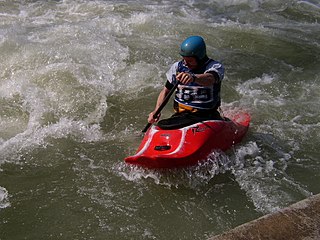
Whitewater canoeing is the sport of paddling a canoe on a moving body of water, typically a whitewater river. Whitewater canoeing can range from simple, carefree gently moving water, to demanding, dangerous whitewater. River rapids are graded like ski runs according to the difficulty, danger or severity of the rapid. Whitewater grades range from I or 1 to VI or 6. Grade/Class I can be described as slightly moving water with ripples. Grade/Class VI can be described as severe or almost unrunnable whitewater, such as Niagara Falls.

The following outline is provided as an overview of canoeing and kayaking:







